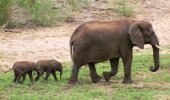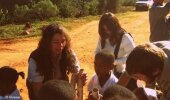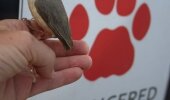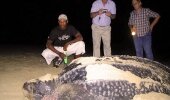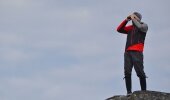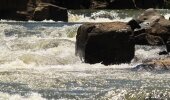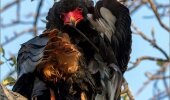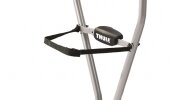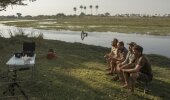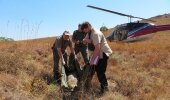Words & Photos: Xen and Adri Ludick
The first of May is not only Worker’s Day, but also Xen’s birthday, so we try to spend this special day somewhere in the bush. This year, we decided to visit Gonarezhou National Park, in southeastern Zimbabwe, because it had been on our bucket list for quite some time.
We left Johannesburg on the Friday afternoon and slept over at Ben Lavin Nature Reserve, just outside Louis Trichardt. We rose early on Saturday morning, and with some trepidation too, as we had to go through the Beitbridge Border crossing. On the South African side, everything went smoothly and we were in and out in less than 30 minutes. We were now ready to face the Zimbabwe side, and were well prepared - or so we thought.
We paid the bridge crossing fee and had our passports stamped, which didn’t take us more than 15 minutes, but then our nightmare started. We still had to pay for a Temporary Import permit, the road access fee, and fuel emission tax, but the computer was offline for about 40 minutes and as a result, everything came to a complete standstill. During this time, there was no orderly queue and people kept pushing in at the front, including all their friends. Furthermore, the security guards had no control over the people; it was pure chaos. Four-and-a-half hours later, we finally left the border post. What we didn’t know at the time, and what we will definitely make use of in future, is that you can book a representative from Zimbabwe Tourism to assist you with border formalities at no additional fee.
The amazing thing about travelling is that once you have crossed a border, you forget about the frustrations of a few minutes ago and the excitement of what lies ahead overshadows everything. The sights and sounds of Zimbabwe soon had us captivated. We watched the local ladies selling mopani worms along the road, we cringed at a motorcyclist’s white helmet that had no straps and the inside lining hung half over his head, and we delighted in the antics of the youngsters attending their herds of cattle.
After Beitbridge, we turned right on the A4 and travelled for about 138 km before turning east at Rutenga towards Boli on a good gravel road. At Boli, we turned left (north) and continued on a scenic road that took us through several villages and delivered us to the southern entrance of Gonarezhou National Park.
There had been heavy rains recently, so we were concerned that the river might be flowing too high and we wouldn't be able to enter the park from the south. However, the lady at the gate’s entrance assured us that we could go through. We arrived at Chipinda Pools Campsite, and Elizabeth, the friendly receptionist, told us that had we arrived two days earlier, we wouldn’t have been able to pass through because the causeway had been impassable. We checked in, bought a wheelbarrow full of mopani wood for U$5, and made our way to the picturesque campsite on the banks of the Runde River. On this short drive, we saw waterbuck, the biggest herd of kudu that we’ve seen in a long time, and impala.
After a refreshing, warm shower in the wonderfully clean ablutions, which were about 100 m from the campsite, we settled under a huge wild mango tree (Cordyla africana) and admired a magnificent sunset. Later that night, we spotted glowing eyes in the bush not far from us and we were so excited the next morning when we discovered that we had captured an African civet on our infrared camera.
The next morning we woke to the call of fish eagles, cooing doves, and Egyptian geese as they flew overhead in formation. There were several hippos in the river and, to our surprise, we discovered tracks of quite a large cat that had also ventured close to our campsite. Our good fortune continued when we received a visitor bearing a handwritten note that read: Mr & Mrs X Ludick. Good morning. I forgot to tell you good news for you, yesterday that you are entitled to one free night if like it. Yours lovely, Elizabeth. How delightful to be told that if you stay for seven nights in the park, you receive an additional free night, courtesy of Zimbabwe Wildlife. After lunch we took a leisurely game drive to Chilojo Cliffs and came across many animals, including impalas, waterbuck, nyalas, warthogs, waterbuck, buffalo, elephant, vultures, ground hornbills, and many other types of birds. Thereafter, we went to the viewpoint that looks out over Runde River, and from where we could see the damaged bridge that had been hit by a cyclone in 2000.
Early that evening we saw elephants quietly grazing across the river from our campsite. We left these gentle giants to go on our late afternoon game drive, which is always very rewarding from a scenery and game perspective. You’ll also see lots of majestic baobabs, wide-open scrublands, and towering sandstone cliffs. Our drive included a visit to Massassanya Dam and on our way there, on the Chivilila Wilderness road, Xen received his biggest birthday present when we witnessed four lionesses savagely devouring their kill. From there, we visited the waterfall at Chivilila and enjoyed the rustic, yet beautiful landscape.
On one of the days we drove through to Chiredzi, 70 km away, to fill up on fuel. We stopped at Mo’s Coffee Shop and treated ourselves to a delicious hamburger and chips. Whilst there, our waiter told us about his cricket ministry, which teaches the boys from the town how to play cricket, and what a positive impact this initiative has had on their behaviour. We were intrigued by his enthusiasm and passion to make a difference in the lives of the children from his community, and we wish him continued success. After five nights at Chipinda Pools, we travelled to Chilojo Campsite No 2 via the Pombadzi Wilderness Area.
About halfway there, we found some workers in the middle of the road trying to cut up a tree that had fallen across the road. Xen offered them our chainsaw and in just a few minutes, the tree was cut and road cleared. Their smiles stretched from ear to ear because they had been struggling for quite a while with their pangas. They then asked us why we hadn’t taken the main track because the one we were travelling on wasn’t in good condition. When we told them that we wanted to see every part of the park, they just shook their heads. It was not an easy road, but we enjoyed the landscape and numerous elephants, ground hornbills, impalas, zebras, giraffes, and more along the way. At one point, Xen even had to remove a kudu carcass that was lying in the road. What intrigued us most was the amount of ant heaps in one area, which looked like small hills, and is something we've never seen before. It took us three-and-a-half hours to travel about 50 km, but it was well worth the effort.
Arriving at Chilojo Campsite, we were curious to know why we had to pay U$10 more per person, per night, for this campsite than at Chipinda Pools, which had nine campsites, three ablutions, and the cleanest campsite we'd ever seen (thanks to Robson who took great pride in his work). At Chilojo, there was no one to keep the campsite spotlessly clean, no ablutions, and just a long drop. It turned out that the additional cost was because we were in a wilderness area.
That evening after we had showered under a tree, we admired a breathtaking sunset over Chilojo Cliffs; a sight that no photo or canvas could ever do justice to. Our nights were spent listening to the loud bark of impalas, the snorting of blue wildebeest, and the chattering of baboons around us. We also heard lions not far from our camp and on our third night, I was out of my chair in seconds when a lion roared about 100 m away from us. Luckily, it moved away and we were able to continue sitting around our little fire, listening to the wonderful sounds of the night. Xen also had a close encounter and got the fright of his life when a bat flew into his chest while we were shining the spot lamp to follow eyes in the nearby bushes, which we suspected to be a smallish cat.
Our days were spent going on various drives and on one of these drives we visited all the campsites in the area to see what facilities they offered. The roads in the park are in good condition and you can see the staff are continuously busy with maintenance work. However, on the road up to Chilojo Cliffs, there was a sign that said: ‘Sedan type vehicles not recommended’. We agreed that it should have have said: 'Strictly 4x4’, especially when we descended from the cliffs via the Chamuchinzu viewpoint and Chidhlambani Pan. At one stage we couldn’t even find the road as the erosion on that specific road was so bad, which was very frustrating. Nevertheless, the view from the Chilojo Cliffs over Runde River, the lush, green plains, and the many animals we saw made the trip worthwhile.
Another memorable game drive occurred when we travelled northeast to find the Save River and Tambahate Pools. On our way towards the river, we passed a number of campsites on the southern side of the river, all boasting the most incredible views over the Runde River. Unfortunately, we weren’t able to reach the Save River as the track just disappeared, so we had to turn around. On our way back, we came across a game warden carrying an AK47. He told us that there were many poachers in the area, so they needed to patrol the area continuously to protect the game.
We then took a drive to Tambahate Pools, which are in the middle of nowhere. The sapphire pools cover an area the size of approximately 20 rugby fields and are filled with lime-green grass and reeds. As you can imagine, the birdlife was unbelievable and we saw marabou storks, black-winged stilts, yellow-billed storks, hamerkop, grey heron, blacksmith plover, woolly-necked storks, egrets, and goliath herons to name but a few. Over lunch, we enjoyed watching a herd of elephants grazing close by, as well as an inquisitive black-backed jackal and lots of impalas and zebras. We then took another track that went around the pools and it felt as if we were in a labyrinth brimming with mopani trees and makalani palms. This area was also teeming with hundreds of elephants, so we travelled very slowly, mindful not to upset them. We also saw a huge eland, an elegant kudu bull, shy klipspringers, and loads of warthogs. You could tell the area did not have many visitors because the impalas were so wild and skittish that they ran away from us and into the safety of the veld.
It was with a heavy heart when we packed up and started our two-day journey back to South Africa, as it had been another very special and memorable trip. We would highly recommend a visit to Gonarezhou National Park, but a visit to Chipinda Pools and the Chilojo Cliffs are just a very small part of this amazing National Park.
Until the next time, safe travels.
Tips for Zimbabwe and travelling in game reserves:
• If you must go over Beitbridge don’t use runners, rather use the service offered by Zimbabwe Tourism. The runners overwhelm you and before you know it, they will pocket a few hundred rands and you’ll be left with the terrible feeling of having being ripped off.
• Try to go in the winter season when you can travel through the Kruger National Park and across the Limpopo River to enter Zimbabwe at Sango Border Post.
• Stop at the road markets and chat to the sellers. They are very friendly and it’s intriguing to find out more about their way of life, especially when they tell you how to prepare mopani worms.
• Don’t be scared to take the loops or go through the wilderness areas in a park. You might just be surprised by what you’ll find. However, teamwork, a good GPS, and maps are necessary when you go off the main tracks.
• You need to be prepared in the event of a breakdown, so that you can get yourself out of trouble if no help is around.
• If you have the means, stop and offer help to the park's workers because they work with limited tools.
• Take the time to stop at different campsites. This will give you a good indication of what is available and where you can camp during your next visits. We always take photos of the campsites and names so that we can remember what it looks like.
